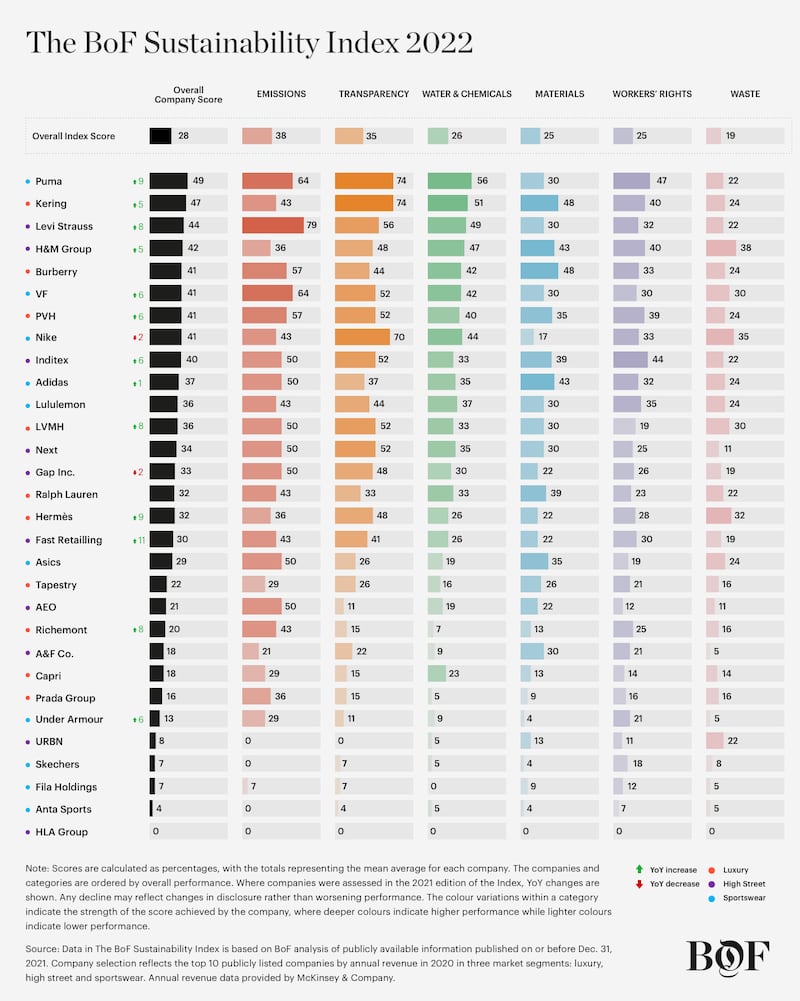
The Business of Fashion
Agenda-setting intelligence, analysis and advice for the global fashion community.

Agenda-setting intelligence, analysis and advice for the global fashion community.

 Opens in new window
Opens in new windowSportswear’s focus on both technical materials to help boost athletic performance and outdoor activities provide the market segment with a clear connection to the environment and innovation. But sportswear is also heavily reliant on synthetic plastic materials and is weighed down by historic links to labour abuses. So how are its biggest companies performing when it comes to reducing negative environmental and social impact?
Every year, BoF Insights benchmarks the sustainability efforts of fashion’s biggest companies within the luxury, high street and sportswear segments to understand the answers to just these kinds of questions. The BoF Sustainability Index assesses companies’ progress towards ambitious environmental and social targets across six impact categories, designed to align with the UN’s Sustainable Development Goals and efforts to curb global warming by 2030.
The 2022 edition of the Index analyses the sustainability performance at 30 of fashion’s largest public companies by revenue as reported in 2020. The performance of the 10 biggest companies in each of the three segments is assessed using a framework of more than 200 questions, with companies gaining a point if their public disclosures indicate they meet the required criteria. The results enable like-for-like comparisons and in-depth market segment analysis on fashion’s sustainability performance.

As a group, the sportswear segment slightly underperformed the overall Index average, but sportswear brand Puma topped the entire Index.
ADVERTISEMENT
The overall average score for the 10 sportswear companies assessed came in at 26 points out of 100, compared to 28 points for the complete Index. Within the individual impact categories, the segment performed more or less on par with the overall Index average in Water & Chemicals, Workers’ Rights and Waste, but underperformed in Emissions, Transparency and Materials.
The segment’s overall performance was dragged down by a significant concentration of companies falling in the bottom portion of the complete Index, with scores of less than 10 points and very limited disclosure of the policies and practices they have in place across any of the impact categories.

Puma tops both the sportswear segment ranking and the complete Index, overtaking Nike, which had led the segment in the previous year’s Index.
Puma’s overall score of 49 points out of 100 reflects particularly strong performance in Emissions and Transparency. Meanwhile, Nike slid back in the rankings to come joint second in the sportswear segment and joint fifth in the complete Index of 30 companies.
A number of companies in the sportswear segment achieved particularly low overall scores, with Skechers, Fila Holdings and Anta Sports receiving an average of less than 10 points out of 100. All three rank in the Index’s bottom five companies. Under Armour, with a score of 13, ranks sixth from bottom.
No company is doing enough to tackle fashion’s sustainability challenges, and while the sportswear segment has a particularly wide distribution between leaders and laggards, its performance largely aligns with the overall findings of the Index: with just eight years left to reach targets, inaction at many of the industry’s biggest players is eclipsing incremental progress among frontrunners, leaving the industry with the need to urgently improve in every area of analysis.

The BoF Sustainability Index examines the 10 biggest public companies by revenue in 2020 in three fashion industry segments: luxury, high street and sportswear. It assesses performance across six impact categories: Emissions, Transparency, Water & Chemicals, Waste, Materials and Workers’ rights.
Within those categories, the companies are benchmarked against 16 ambitious environmental and social targets established by The Business of Fashion in consultation with a group of respected global experts. Each target contains a series of binary metrics (201 in total), which BoF researchers scored “yes” or “no” based on information that was publicly available on or prior to Dec. 31, 2021.
ADVERTISEMENT
More information on the methodology is available in our FAQs, or purchase the report from BoF Insights to review it in full.
This article forms part of a series also addresses the performance of the luxury and high street segments.
For more BoF sustainability coverage, sign up now for our new Weekly Sustainability Briefing by Sarah Kent.
The BoF Sustainability Index is based on a binary assessment that examines companies’ public disclosures up until Dec. 31, 2021. It should be viewed as a proxy for sustainability performance and not an absolute measure. BoF accepts advertising arrangements from a range of partners, some of which may appear in The Sustainability Index. Such advertising arrangements and the Index are handled by separate parts of the business. LVMH is part of a group of investors who, together, hold a minority interest in The Business of Fashion. All investors have signed shareholders’ documentation guaranteeing BoF’s complete editorial independence.
Efforts to transform the fashion industry in line with global ambitions to curb climate change and establish more responsible business practices by 2030 have yet to gain sufficient momentum, The BoF Sustainability Index 2022 finds.
Kering and Burberry top the luxury ranking in this year’s BoF Sustainability Index, while Prada, Capri, Richemont and Tapestry lag.
Puma tops The BoF Sustainability Index 2022, but Skechers, Fila Holdings and Anta Sports all rank in the assessment’s bottom five.
Levi Strauss and H&M Group rank among the top five companies in The BoF Sustainability Index 2022, but the high street segment also contains the annual assessment’s lowest-scoring company with no points at all.

Sarah Kent is Chief Sustainability Correspondent at The Business of Fashion. She is based in London and drives BoF's coverage of critical environmental and labour issues.
The trial of Colombian designer Nancy Gonzalez for smuggling alligator and snakeskin handbags into the US shone a rare public spotlight on the trade in the exotic skins used for some of fashion’s most expensive and controversial products.
Europe’s Parliament has signed off rules that will make brands more accountable for what happens in their supply chains, ban products made with forced labour and set new environmental standards for the design and disposal of products.
Fashion’s biggest sustainable cotton certifier said it found no evidence of non-compliance at farms covered by its standard, but acknowledged weaknesses in its monitoring approach.
As they move to protect their intellectual property, big brands are coming into conflict with a growing class of up-and-coming designers working with refashioned designer gear.